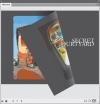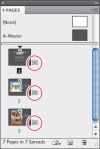Page Transitions
As the user navigates from page to page in your project, it's (usually) obvious to them that they're reading through a multipage document. If you provide buttons that lead them to the next page, they'll click on a "next page" button and the current page will be replaced by the next one (more about that in the next chapter). But if you'd like a fancier transition from one page to another, you might want to explore InDesign's built-in page transitions. You may have seen the default Page Curl (way too cute), but there are others.
- In the Page Transitions folder inside the Ch_4_Exercises folder, open Paintings.indd. Resave the file as PaintingsWorking.indd in the same folder. Drag on the corner of the Preview panel so that you can more easily experiment with the default page curl, and set it to Preview Document mode (
 ). If necessary, click the Play triangle in the bottom left corner of the Preview panel to render the document. Hover your cursor over the upper-right or lower-right corner of the cover page of the project, and you'll see the "paper" start to curl, much like a real magazine page. Hold down the mouse button and keep dragging toward the left side of the Preview window, and the experience is much like turning the page in a magazine printed on very thin paper (Figure 4.20). In fact, you may find it difficult to let go of the page in order to complete the transition to the next page—it's sort of like that scene in
National Lampoon's Christmas Vacation
when Chevy Chase is trying to read a magazine with pine sap on his hands. You'll be relieved to know that the experience is much better in the exported SWF.
). If necessary, click the Play triangle in the bottom left corner of the Preview panel to render the document. Hover your cursor over the upper-right or lower-right corner of the cover page of the project, and you'll see the "paper" start to curl, much like a real magazine page. Hold down the mouse button and keep dragging toward the left side of the Preview window, and the experience is much like turning the page in a magazine printed on very thin paper (Figure 4.20). In fact, you may find it difficult to let go of the page in order to complete the transition to the next page—it's sort of like that scene in
National Lampoon's Christmas Vacation
when Chevy Chase is trying to read a magazine with pine sap on his hands. You'll be relieved to know that the experience is much better in the exported SWF.

Figure 4.20 The default SWF page curl is similar to turning pages in a printed magazine.
- Launch your default Web browser, choose File > Open File, navigate to the PaintingsExport folder inside the Page Transitions folder, and open Paintings.html. Try turning the pages in your Web browser, and you should find that the page-turning behavior is much more natural. When you drag far enough toward the opposite side of the screen, the page should turn—and stay that way. Note that the page turn works whether you are paging forward or backward in the project, but only works when you click the corners, not on the straight edges of the page.
- Return to InDesign so you can explore more page transition options. If you rely on the page curl to take a reader from page to page, you may find you don't need navigation buttons in a simple document. But you'll have to make sure they know to peel the pages by the corners, and that isn't obvious. You may decide that, however cute the page curl might be, you'd still like to provide buttons as a more obvious method of turning pages. But that doesn't mean you can't still entertain the user during the page-turning experience. It's time to experiment with page transitions. In the Layers panel, reveal the Nav Buttons layer; "next page" and "previous page" buttons have already been created for you.
- In the Pages panel, select all seven page thumbnails. From the Pages panel menu, select Page Transitions > Choose to see the dozen page transition effects available (Figure 4.21). The examples themselves are animated; roll your cursor over one of the options to see the transition in action. Choose the Dissolve transition by clicking the radio button under its example, and click OK.

Figure 4.21 Page transition options. Roll over each option, and the example becomes animated to show you the effect. Note the option to apply to all spreads. All page transitions translate to interactive PDF except the Page Turn transition.
If necessary, set the Preview panel to Preview Document mode. In the Preview panel menu, choose Edit Preview Settings and turn off the Include Interactive Page Curl option (Figure 4.22); the Page Curl option is on by default. Having the curl won't prevent your page transition effects from working, but the cumulative effect of the Dissolve transition, the page curl, and the navigation buttons would probably be sensory overload for a reader. As they attempted to click the navigation button for the next page, the page would unexpectedly curl, then dissolve... well, it would just be too much. There's something to be said for restraint.

Figure 4.22 To test page transitions, turn off the Include Interactive Page Curl option. Remember this option if you do want the page curl and wonder why it isn't working (the option is on by default).
Click through the document in the Preview panel; what do you think of the Dissolve transition?
If the twelve page transitions aren't enough, you can customize the behavior of the transitions to shake things up (Figure 4.23). Open the Page Transitions panel (Window > Page Transitions), and select the Push transition. Click the Direction pull-down to see the options, and select the Right Up option. Click the Speed pull-down to see that you can choose from Slow, Medium, and Fast. Leave the Speed option at the default: Medium. Click the Apply to All Spreads icon in the lower-right corner of the panel, and check the results in the Preview panel.

Figure 4.23 You can customize page transitions by changing the speed and direction. Click the Apply to All Spreads icon (circled) if you neglected to select all spreads beforehand.
Experiment with other transitions; edit them to see what works best for this document. You can even apply a different transition to each page. (Remember: just because you can, that doesn't mean you should. Control the urge.) Pages with a transition assigned will display a small icon in the Pages panel (Figure 4.24). You can also choose page transitions from Layout > Pages > Page Transitions > Choose (they just hide these little goodies everywhere, don't they?).

Figure 4.24 A small icon (circled) indicates which pages have been assigned page transitions.
- Even if you pull on the corners of the Preview panel for a larger preview, you should still export to SWF and view the results in a browser for the full effect. What looks amusing in the Preview panel may prove to be overwhelming at full size in the final state. Decide on the page transition (or transitions) that you feel would be suitable for this small catalog of an artist's work, and choose File > Export. Choose Flash Player (SWF) for the format, and navigate to the folder named Paintings (Your Version) inside the Page Transitions folder. Name the SWF Paintings.swf. In the export dialog, use the following settings:
- Generate HTML File: This enables you to view directly in a browser.
- View SWF after Exporting: Automatically displays the SWF in your default browser.
- Scale: 100%
- Background: Paper Color—even though the project has a charcoal gray background; if you check Transparent, page transitions won't be included.
- Page Transitions: From Document, to preserve your choices. Note that you can select a transition from the pull-down menu, though, and override existing page transitions during export.
- Options: Uncheck the option to Include Interactive Page Curl.
- Page through the Paintings project in your browser and see what you think. Do you like the transition (or transitions) you chose? Do the page transitions enhance the reader's experience, or do they compete for the reader's attention, detracting from the paintings, which are the central subjects? You might even decide to dispense with the fancy transitions after all, and just let the reader move sedately from page to page using the navigation buttons. It's up to you.
If you want to remove all page transitions and start over, select a page thumbnail (or multiple thumbnails) in the Pages panel and, from the panel menu, choose Page Transitions > Clear All. If you want to disable the page transition for a single page, the easiest way is to select the page thumbnail in the Pages panel, then right-click (Mac: Control-click) and choose Page Transitions > Clear Page Transition from the contextual menu.